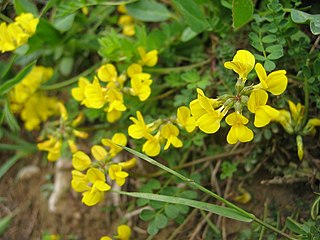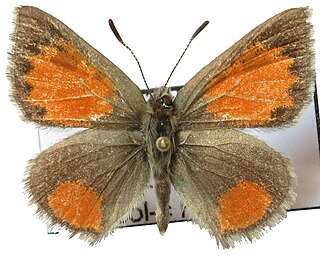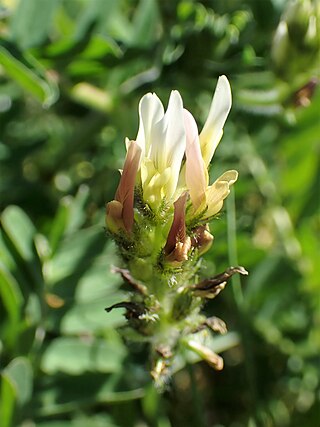
The Atlas Mountains are a mountain range in the Maghreb in North Africa. It separates the Sahara Desert from the Mediterranean Sea and the Atlantic Ocean; the name "Atlantic" is derived from the mountain range. It stretches around 2,500 km (1,600 mi) through Morocco, Algeria and Tunisia. The range's highest peak is Toubkal, which is in central Morocco, with an elevation of 4,167 metres (13,671 ft). The Atlas mountains are primarily inhabited by Berber populations.

Colias croceus, clouded yellow, is a small butterfly of the family Pieridae, the yellows and whites.

The Adonis blue is a butterfly in the family Lycaenidae. It inhabits the Palearctic realm.

Hippocrepis comosa, the horseshoe vetch, is a species of perennial flowering plant belonging to the genus Hippocrepis in the family Fabaceae.

The wildlife of Morocco is composed of its flora and fauna. The country has a wide range of terrains and climate types and a correspondingly large diversity of plants and animals. The coastal areas have a Mediterranean climate and vegetation while inland the Atlas Mountains is forested. Further south, the borders of the Sahara Desert are increasingly arid. Large mammals are not particularly abundant in Morocco, but rodents, bats, and other small mammals are more plentiful. Four hundred and ninety species of birds have been recorded here.

Tomares ballus, the Provence hairstreak or cardenillo, is a butterfly of the family Lycaenidae. It is found on the Iberian Peninsula, northern Africa and along the Mediterranean coast of France.

Lysandra albicans, the Spanish chalk-hill blue, is a butterfly of the family Lycaenidae. It is found in Spain and Western North Africa.

Polyommatus escheri, Escher's blue, is a butterfly of the family Lycaenidae. It is found in Southern Europe and Morocco.

Hipparchia hansii is a species of butterfly in the family Nymphalidae. It is endemic to the North African region, mainly Morocco, Algeria, Tunisia and western Libya. Its natural habitats are dense soil, grazed and rocky slopes, and ridges. It prefers to stay in the shade. This is one of the last butterflies that flies in the season.
Coleophora valesianella is a moth of the family Coleophoridae. It is found in Europe south of the line running from France to Austria and Romania. It has also been recorded from Cyprus.
Coleophora onobrychiella is a moth of the family Coleophoridae. It is found from Sweden to the Pyrenees, Italy and Greece and from France to Romania. It is also found in China.

Tomares romanovi, or Romanoff's hairstreak, is a butterfly of the family Lycaenidae. It is found in Armenia, Azerbaijan, Georgia, eastern Turkey, northern Iran, and Kopet Dagh mountains.

Tomares callimachus, the Caucasian vernal copper, is a butterfly of the family Lycaenidae. It is found in Anatolia, Iraq, Iran, the Caucasus, and Transcaucasia.

Tomares nogelii is a small butterfly found in the Palearctic that belongs to the blues family.

Kretania martini, or Martin's blue, is a species of North African butterfly in the family Lycaenidae and the subfamily Polyommatinae.

Astragalus boeticus, the yellow milk vetch, or Swedish coffee is a species of annual herb in the family Fabaceae. It is native to the Mediterranean and the Middle East.

Hyponephele maroccana, the Moroccan meadow brown is a butterfly of the family Nymphalidae. It is endemic to Morocco

Lycaena phoebus, the Moroccan copper, is a butterfly in the family Lycaenidae. It is endemic to the Atlas Mountains of Morocco. It flies according to the place from April to September or simply from August to September in a variable number of generations. Its host plant is Polygonum aviculare in the High Atlas and possibly Polygonum equisetiforme in the Anti-Atlas. The biotope is flowery meadow.

















